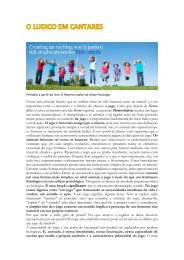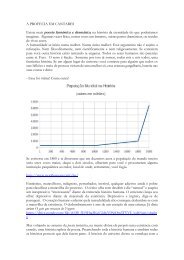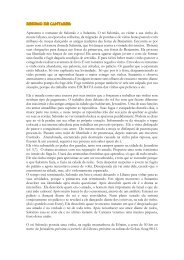Motherhood in Childhood
Create successful ePaper yourself
Turn your PDF publications into a flip-book with our unique Google optimized e-Paper software.
The onset of puberty br<strong>in</strong>gs substantial<br />
physical changes, as well as vulnerabilities to<br />
boys and, especially, to girls. Puberty for girls<br />
beg<strong>in</strong>s on average two years earlier than for<br />
boys. This fact, comb<strong>in</strong>ed with very restrictive<br />
gender norms and limited assets, often leaves<br />
many girls with only their physical bodies as a<br />
core reliable asset. This asset can be potentially<br />
exploited for non-consensual, unprotected,<br />
and underage sexual relations; and it may also<br />
subject girls to marriage aga<strong>in</strong>st their rights and<br />
will, with the expectation that they will bear<br />
children as soon as possible.<br />
For most children, early adolescence is<br />
marked by good health and stable family<br />
circumstances, but it can also be a period of<br />
vulnerability because of <strong>in</strong>tense and rapid<br />
transitions to new roles and responsibilities as<br />
caretakers, workers, spouses, and parents. In<br />
many countries, the impact<br />
of HIV, poverty, and political<br />
and social conflict on families<br />
and communities has eroded<br />
traditional safety nets and<br />
<strong>in</strong>creased the vulnerability of<br />
young adolescents (UNFPA<br />
and the Population Council,<br />
n.d.).<br />
When children of this age<br />
are neither liv<strong>in</strong>g with their<br />
parents nor attend<strong>in</strong>g school,<br />
there is a good chance that<br />
they are not receiv<strong>in</strong>g familial<br />
or peer support to properly<br />
deal with the challenges<br />
they face and are not be<strong>in</strong>g<br />
given adequate opportunity<br />
to develop <strong>in</strong>to productive<br />
members of society. In some<br />
sett<strong>in</strong>gs, young female adolescents are domestic<br />
workers, migrants from rural communities <strong>in</strong><br />
search of work and an education, or are flee<strong>in</strong>g<br />
a forced marriage. Others may already be child<br />
brides and are now liv<strong>in</strong>g with their spouse and,<br />
possibly, his family. These youth are among<br />
the least likely to seek out and receive social<br />
services and therefore require a proactive set of<br />
prescriptions to m<strong>in</strong>imize their vulnerability to<br />
exploitation.<br />
DHS data from 26 sub-Saharan African<br />
countries show that up to 41 per cent of girls<br />
between the ages of 10 and 14 were not liv<strong>in</strong>g<br />
with either parent (although some may been<br />
liv<strong>in</strong>g with other relatives). Somewhat smaller<br />
shares of girls <strong>in</strong> that age group were not liv<strong>in</strong>g<br />
with either parent <strong>in</strong> Lat<strong>in</strong> America and the<br />
Caribbean. The lowest proportions were <strong>in</strong><br />
Asia (World Health Organization, 2011b).<br />
“When I went <strong>in</strong>to labour, they brought the<br />
traditional daya midwife. She didn’t pay<br />
attention to the size or the position of the<br />
fetus. The whole day, I was <strong>in</strong> pa<strong>in</strong>, hold<strong>in</strong>g<br />
onto the rope until I had no energy left <strong>in</strong><br />
me. I thought I was go<strong>in</strong>g to die. Then they<br />
took me to the hospital, which was over<br />
two hours away. The moment I reached<br />
there I lost consciousness. And when I<br />
woke up, they told me my baby had died.”<br />
Awatif, 33, pregnant at 14, Sudan<br />
54 CHAPTER 3: PRESSURES FROM MANY DIRECTIONS

















